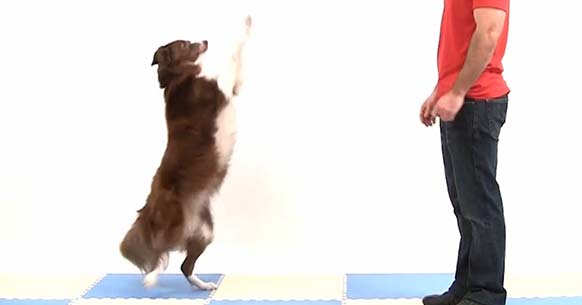How To Train A Dog To Stand On Its Hind Legs
Not too long ago I was looking at videos of show dogs. You know—those dogs that can do amazing things on talent shows. One trick in particular struck me as simply amazing. I saw a dog stand and walk on his hind legs, and I thought it was the coolest thing ever. So I decided to teach it to my dog. And it worked!
Here’s a video of how I did it, and it’s only four minutes long.
I have added some additional training information and tips below. Be sure to read them when you teach your dog this trick.
STAGE 1
Before you begin training your dog, it is important to note that standing tall on its hind legs is not a natural behavior for your dog. This is not going to be comfortable, especially if you have a larger dog. Smaller dogs usually have a much easier time with this trick.
I must also caution you that if you have any concern about your dog’s hips or hind legs, or if your dog has a history of injury in that area, then you should not attempt to train for this trick. Your dog’s health and well-being is much more important than a trick.
Let’s begin. The first thing is to teach your dog that great things will happen if it stands on its hind legs. That’s why you need to reward your dog when it moves into that position.
Begin by placing your dog in a sitting position, and then place a treat above your dog’s head. Next, you move your hand upward and toward your dog’s back. The goal is to get your dog’s front legs off the ground. As soon as this happens, reward your dog immediately. Continue to reward your dog while gradually moving the treat higher and higher.
The final goal is to get your dog to stand tall on the tip of its toes, as seen in the video. Make sure that your dog doesn’t put its paws on you when doing this trick; your dog should learn to balance itself without your help.
Practice this exercise at least twenty times. Your dog should be comfortable in this position before moving on.
STAGE 2
Once you can easily lure your dog into the stand tall position, the next step is to begin conditioning a hand signal. This step is to avoid having your dog become dependent on you holding a treat above its head to do the trick. You will be able to trigger this behavior from a distance, which looks much more impressive.
The easiest way to do this step is by creating a pattern (e.g., 3:1), which means three lures followed by one hand signal. This works great because it sets your dog up for success. Your dog will anticipate what you want it to do, and it will stand tall even though you don’t have a treat in your hand.
In the beginning, make your hand signals identical to your lure. Basically, this is the same motion as your lure but without any food inside. You can see more clearly what I mean in the video above.
Next, while ensuring that your dog is successful and being rewarded for every repetition, you can slowly make changes to your hand signal. Preferably, move your hand away from your dog and use your index finger pointing up as the hand signal.
The key here is to refine your hand signal to the degree of perfection you want before moving to stage three.
STAGES 3 & 4
Once you can consistently signal your dog to stand tall and you have refined your hand signal to the degree of perfection you want, you can begin conditioning a verbal command. Saying your verbal command just before you give your hand signal easily accomplishes this. However, it is important that you leave a small pause between the two so your dog learns that verbal commands are what trigger the hand signal.
A common mistake new trainers make is that they say their command at the same time they give their hand signal. You really must say “Stand,” and give your hand signal after. Practice this at least twenty times, and then start testing your dog’s understanding of the command.
You can test your dog’s understanding by creating a pattern in which you say your command (e.g., “Stand”) followed by a hand signal three times in a row. Then, on the fourth repetition you simply say “Stand” and see if your dog responds to your verbal command. If your dog responds, then great! Make sure that you celebrate with a treat and lots of praise.
However, if your dog does not respond, this usually means you need more conditioning with hand signals. Also, you might want to record your training sessions to see if you project any subtle body language that your dog might be picking up instead of your verbal command.
For example, a common mistake people make when training their dog to lie down is to say “Down” while nodding their head or looking down. Although this seems harmless, some dogs will learn to ignore the command and simply wait for the head movement. As you can imagine, this is problematic if the owner is not directly in front of the dog.
CONCLUSION
I am so happy you have decided to teach your dog this trick. I think you’re going to love it, especially once you see people’s reaction to it. Although it’s extremely simple to teach, people will think your dog is a genius.
Have fun with it!
NOTE: By the way, I have written an in-depth guide about the four stages of luring. Be sure to read it if you want to apply it to teaching your dog other behaviors and tricks. It’s available here.

